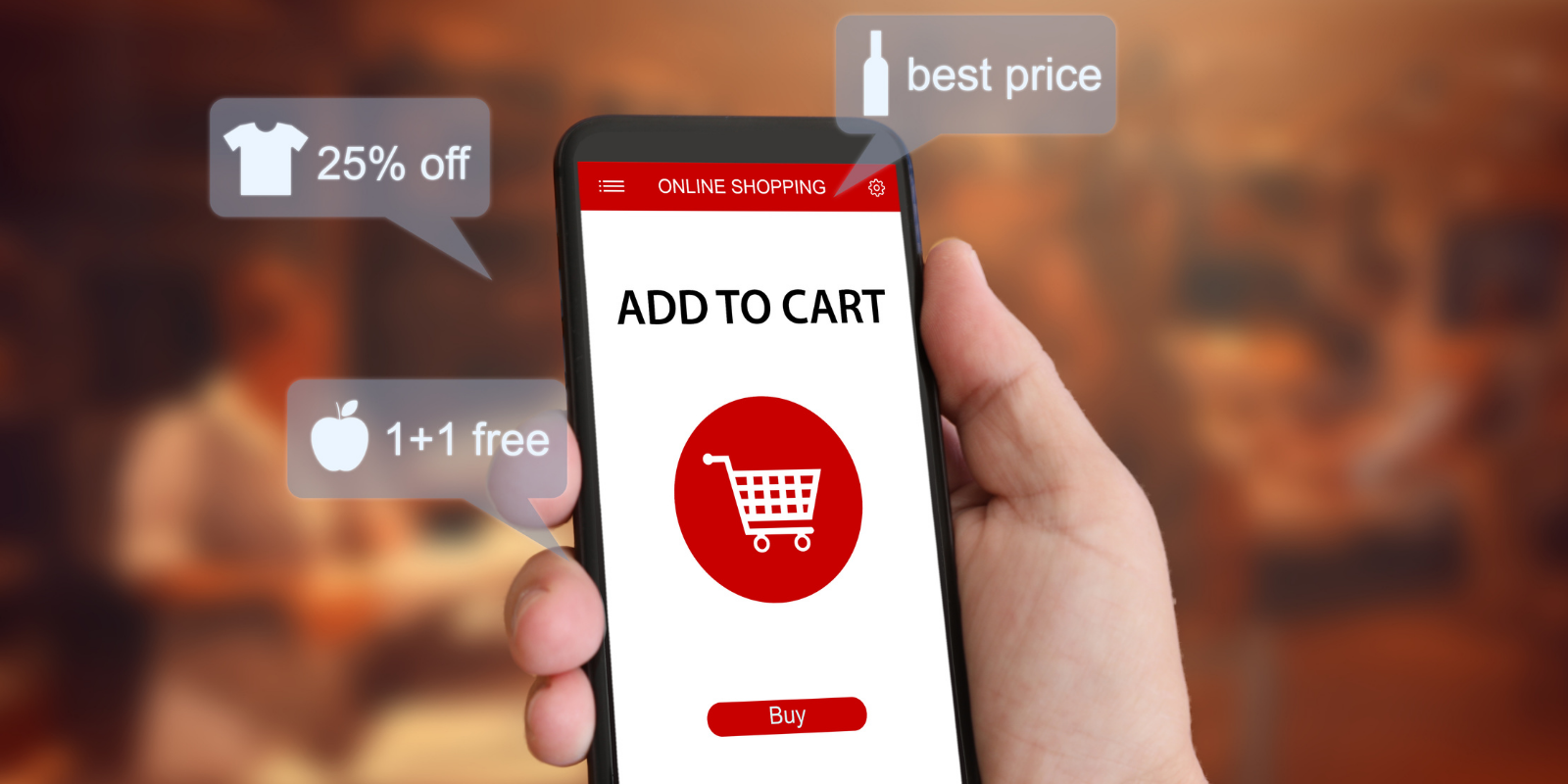Top 5 Ecommerce Trends to Follow in 2025

In this article
Trend #1. Mobile Commerce
Trend #2. Social Commerce
Trend #3. AI-driven personalized product recommendations
Trend #4. Visual Commerce
Trend #5. Omnichannel Commerce
More eCommerce trends to watch out for
Conclusion
The year has finally ended with all its problems and challenges. And we believe the new year promises to be rich with exciting discoveries and innovations.
So, there is no time to relax. With the rising competition in the eCommerce world and customer demand becoming more diverse, establishing a solid digital presence has become an absolute must. Let’s check out how online stores will evolve and how they will provide more exceptional experiences for their audience.
Here is our list of the top 5 most remarkable eCommerce trends to follow. We’ve also gathered a collection of hands-on tips and the best eCommerce marketing tools to help your online store succeed this year.
Trend #1. Mobile Commerce
As one of the most promising mobile commerce trends, mobile shopping is slowly but steadily overtaking eCommerce. So, it’s no surprise that in 2021, eCommerce growth is being driven mainly by mobile commerce. At the beginning of 2021, Statista experts estimated that m-commerce would make up to 73% of all eCommerce sales compared to 52.4% in 2016.
In other words, today, almost three out of every four dollars spent on online purchases are mobile-driven. These numbers clearly show that consumers and marketers have already highly appreciated the advantages of electronic and mobile commerce.

The first question any online merchant should answer is whether their online website is mobile-optimized. According to the latest mobile commerce statistics, 67% of respondents named too small-to-click page elements as the biggest barrier to mobile shopping. So, if you want to stay competitive, improving your mobile user experience should become one of your priorities.
One more reason your online store should be mobile-friendly is that the better your store looks and runs on mobile devices, the more chances you have to get higher Google rankings.
How to optimize your online store for mobile

The desktop experience can include complex, layered navigation, and other high-end stuff, while the mobile experience should minimize nonessential components. So, pay careful attention to the layout of your mobile version when creating a mobile commerce strategy:
Clean up your wording. Eliminate every unnecessary word from your pages. Mobile shoppers are precise in their queries. Provide only the most relevant information based on the customer’s current stage in the sales funnel.
Optimize images. Make sure your images are the appropriate size and resolution to fit any mobile screen. There is a great variety of tools that help to edit uploaded images depending on your page width.
- Improve store navigation. The primary rule here is no popups and heavy-looking sidebars. They downgrade the user experience and make it harder to browse the store.
- Use thumb-friendly CTAs. CTAs for mobile should be big enough so that shoppers can easily tap them. Use contrasting colors to make them stand out against the background.
- Upgrade the search bar. If possible, offer search auto-suggestions, corrections, and auto-completions to streamline the product search engine process and improve user experience.
No, being mobile-oriented is not a new trend. However, building customer trust in mobile commerce has been continuously gaining traction over recent years and will develop more in the future.
Below we’ve listed some eCommerce technology trends that will help you make your store even more user-oriented:
- Virtual fitting rooms for clothing stores: This will help users try on any store item when they are on the go. And, as a result, they’ll make a purchase decision much faster.
- Chatbots instead of consultants: Chatbots are an excellent replacement for shop assistants helping to pick the correct size. They can also trace the order status and ask for feedback. All of these features reduce the number of returns and increase customer satisfaction.
- GPS-enabled mobile shopping: If you run a brick-and-mortar business, you can offer your own GPS-enabled mobile shopping experiences that help customers to make in-store purchases easier.
Trend #2. Social Commerce
“The potential for social commerce today is “infinite”… Every eCommerce site will have to adapt.”
— Bing Gordon
Social media platforms and eCommerce businesses have become an indispensable part of our everyday lives. They both know it and thrive on creating mutually beneficial projects to deliver products to shoppers. Today, billions of customers visit social media channels like Instagram, Facebook, and TikTok to discover new brands and products.
For instance, according to Meta for Business social commerce research, 63% of consumers who use Facebook use it for shopping.

In August 2021, TikTok expanded its partnership with Shopify and presented its pilot TikTok Shopping feature in the US, Canada, and the UK. This promises to be a new milestone for the whole social commerce sphere.
The numbers show that about 60% of TikTok users are generation Z with its love for fast fashion and spending more money on beauty products. So, it will come as no surprise that we’ll see more fashion and beauty brands on TikTok. For example, Kylie Jenner was among the first to adopt TikTok Shopping with her cosmetics brand.

Social commerce is a perfect fit for those customers who don’t want to spend time reading long product descriptions and browsing numerous store categories. This is for people with the “I like it, I buy it mentality” who want to see the product they need, add it to the cart and proceed to checkout.
Although Instagram seems to be the number one platform serving the interests of this audience, TikTok Shopping is a strong competitor offering merchants and customers many more shopping opportunities and new experiences.
What to expect from social media marketing
Of course, you can hardly imagine social commerce without social media marketing. With testimonials, reviews, and user-generated content, it creates tons of valuable insights for your potential customers. Let’s take a quick look at the upcoming trends to welcome the new year in fully prepared.
Importance of influencer marketing
Influencer marketing is one of the most powerful tools for converting brand awareness into actual online sales. The experts predict that influencers or brand ambassadors will outperform the overwhelming majority of other word-of-mouth tools in terms of cost-effectiveness. They’ll continue sharing their unique product recommendations to their highly engaged audiences and exploit the potential of referral marketing eCommerce programs to the full.

Since brands are shifting their focus from measuring customer engagement to tracking sales and conversions, niche influencer marketing will come in handy and has a high potential to expand into affiliate programs. Influencer campaigns and affiliate programs will increasingly merge to help businesses get the most out of authentic influencer content. In addition, a commission-based pay-per-conversion affiliate model helps brands cut down on their ad expenses and works perfectly for any business.
Learn more about the advantages of affiliate, influencer, and referral marketing in our partner marketing guide.
Never used Tapfiliate to track influencer marketing performance? Try all the features: ?get a 14-day free trial here
Connecting storefronts with social media accounts
Social media has become an extremely popular eCommerce channel, which is especially great for building brand authenticity. In addition, by connecting your online store with your social media pages, you will turn your business profile into a centralized selling platform. As a result, your customers won’t have to visit a third-party website to make a purchase. This is an easy yet effective trick that keeps shoppers engaged with your brand for longer.
Shifting to short-form content pieces
The popularity of short videos and other short-form content types will continue to grow. Of course, long-form content like podcasts, videos, or blog posts still does the job when appropriately channeled. However, breaking it into bite-sized pieces for social media platforms such as TikTok, Instagram Stories, or YouTube Shorts will be a wise decision. By picking up the right formats and distributing your content accordingly, you have more chances to have your brand’s voice heard.
Building a community around your brand
For years, online communities have played a crucial role in connecting consumers and businesses. However, the importance of brand communities has increased due to global pandemic issues. Why? Because people feel frustrated and insecure being isolated in their homes, working remotely, and changing their daily routines. Brands that care about their clients feel the need to support them and seek the most effective ways to stay in touch.
And while brand communities have proven to be great at building customer loyalty and improving retention, more and more companies choose to build communities around their brands.
Trend #3. AI-driven personalized product recommendations
Research over recent years shows that almost 40% of US consumers would rather purchase a more expensive product than they originally planned because of a more personalized shopping experience.
Artificial intelligence (AI) predicts customer shopping habits based on browsing and shopping history. So, when it comes to personalized product recommendations like upsells or cross-sells, AI-powered technologies are beyond competition. While no human brain could create a separate website tailored to the specific needs of each particular visitor, AI is up for the task.
We’ll see the focus shift to AI-driven hyper-personalization, where every interaction with a customer will be based on real customer needs.
Sounds promising, but how does it work for your specific online store? There are dozens of forms of product recommendation. And knowing their specifics, you can easily combine them to maximize their impact on customers’ purchase decisions.
- Upselling is a technique that offers similar but more expensive or premium products. This tactic is beneficial if you sell products of different pricing segments and aim to increase your average order value (AOV).
- Cross-selling is about suggesting additional or complementary items to those already added to the cart. For example, air pods will become a good cross-sell product for smartphones.
- Post-purchase upselling is a risk-free tactic that allows merchants to re-engage their customers right after purchase completion. It shows upsell offers on the “thank you” page and usually offers a tempting discount.
See the example of a cross-selling widget by Sephora.com.

Looking for even more sophisticated solutions based on machine learning in eCommerce? Consider the Amazon-like AI-powered feature for instant product recommendations. In 2018 Amazon launched the Scout feature that promised to amaze store visitors with precisely tailored product suggestions in real-time. It was game-changing.
Unfortunately, this technology’s potential and hidden powers seem to have been underestimated so far. However, in the wake of the growing popularity of personalized approaches and the lightning-fast development of machine learning technologies, it is a good idea to try them for your eCommerce strategy.
Trend #4. Visual Commerce
We live in the era of information noise, meaning businesses compete for consumers’ attention using everything possible. Remarketing, retargeting, triggered email campaigns, pop-ups, widgets, context ads — this list seems to be endless. But as we mentioned above, a large cohort of consumers just want to quickly add the product to the cart and complete the purchase. I want it; I got it!
That’s why visual communication is more important than ever. And brands can implement visual tactics like high-quality pics, videos, and even AR to keep customers engaged.
What is visual commerce?

In a nutshell, visual commerce is the strategy of employing images, videos, and other graphic stuff to help customers learn more about your product quickly and make purchase decisions faster.AR tools for visual commerce
Here are the tips on how you can get more from visual commerce marketing:
1. Use a WebP format instead of JPG and PNG. This simple image upgrade will improve the quality of your product presentation and increase the loading speed of your pages.
2. Equip your store with a visual search feature to let customers search for products by image.
3. Make visual content searchable with the proper descriptions and tags to help visitors quickly discover products on your site.
4. Repurpose user-generated content for your product pages, turning them into shoppable galleries to increase user engagement, build credibility, and boost conversion rates.
Get inspired by the most prominent examples of user-generated content by Calvin Klein:

5. Use augmented reality (AR) to think out of the box and provide your clients with the ultimate shopping experience. With AR technology, they can use a mobile phone or a laptop to watch a live video and virtually try and “taste” the product they want to buy.
6. Create shopping ads for Pinterest to drive traffic to your online store and increase sales.
7. Offer interactive 3D visuals for configurable products, as well as for your best-sellers.
8. Employ shoppable imagery so that you can easily redirect customers to the corresponding product page after clicking on a product image they like.
Trend #5. Omnichannel Commerce
We all live in an omnichannel environment, and to succeed, you must be on top of it. Just imagine! Around 87% of merchants believe that an omnichannel marketing strategy is critical for their business success. And according to Omnisend, using three or more channels instead of one results in a 287% higher purchase rate.
But first things first. Let’s start with the basics and determine the difference between omnichannel and multichannel.
Multichannel is the strategy that assumes a company’s presence on various platforms or channels like mobile apps, websites, social media, or even brick-and-mortar stores. But today, users prefer to have a seamless experience when interacting with your brand instead of endless shifting between separate channels. And this is where the omnichannel solution comes in handy.
An omnichannel strategy for eCommerce is specially developed for those cases when shoppers start looking for products or services on one channel and then seamlessly move to another as the next step of their customer journey. In other words, an omnichannel approach complements a multichannel strategy and optimizes it for modern users’ needs.
And now, let’s take a look at the benefits to understand why the future belongs to the omnichannel approach.
- Cohesive messaging: One of the main advantages of omnichannel eCommerce is that you can always provide your audience with cohesive messaging about your brand. It doesn’t matter where a customer encounters the brand; the messaging remains the same. It helps to build your brand’s authenticity and creates a positive user experience.
- Having a clear picture of your customer journey: Omnichannel eCommerce helps you to easily collect, merge, and process customer data from various channels. And it means that the more data you combine, the more accurate portraits of your target personas you can create.
- Personalizing the customer experience: Did you know that omnichannel customers have a 30% higher LTV (lifetime value) than those using only one channel? This is because the omnichannel approach creates a fruitful ground for personalization. And, of course, understanding your customers’ behavior gives marketers almost unlimited opportunities to make relevant value propositions and channel them accordingly.
More eCommerce trends to watch out for
Of course, many more trends will shape the eCommerce industry this year. Depending on your business niche, geolocation, marketing budget, and other circumstances, you can also consider the following forecasts:
- New focus on sustainability and eco-consumerism. The trend for eye-catching nontrivial packaging is constantly in demand, as it effectively attracts customers and helps brands stand out in the crowd. However, 60% of online users say they are ready to pay more for eco-products. In addition, consumers and corporations will gradually shift to renewable energy and sustainable environmental practices. So, to stay environment-friendly and follow the latest eCommerce packaging trends to conquer new audiences, we recommend you go green and rethink your approach to packaging.
- Multichannel support. Today, almost every company tries its best to provide customers with top-notch support. Want to make your clients even happier? Find out which support channels work better for your audience and make them available 24⁄7. But how can you do this? Some prefer live chats or phone calls, and others prefer to contact you on social networks or messengers. So, keeping all support requests under control requires time and resources. Adding an eCommerce virtual assistant will optimize your customer service workload and enhance the customer experience.
- Fast payment methods. This is one of the hottest eCommerce payment trends. Fast fashion, fast shopping, fast payment methods. The whole world moves quickly, so should your store. Instant payment options along with fast checkout have a direct impact on your revenue growth. That is why customers should have the opportunity to pay instantly, without hopping from platform to platform or going through complicated registrations. There are many instant payment solutions available, and we expect to welcome more services this year.
- Subscription models growth. Subscription models have already proven viable for various online businesses. And we predict that more companies will be seeking new ways to shift to SaaS. The model effectively builds customers’ loyalty, and they are more likely to return to you again and again. However, you should consider your unit economics first and prepare to transition from classic customer support to customer success.
Conclusion
The new year brings new opportunities and new challenges to the eCommerce community. Cutting-edge technologies, cool designs, and tons of new marketing tools will definitely help you easily shape your eCommerce strategy to find your own niche and get to the top.
Just keep your finger on the pulse, don’t give up searching for new approaches, and test them straight away. The sooner you adopt new technologies, the more chances you have to stay ahead of your competitors.

Alena
I’m the digital marketer here at Tapfiliate. I’m a keen researcher, passionate about wrapping difficult things in simple words so that any reader grasps them easily. In my free time, I read books on marketing, psychology and play the kalimba. You can reach out to me on LinkedIn, and here: alena@tapfiliate.com


















